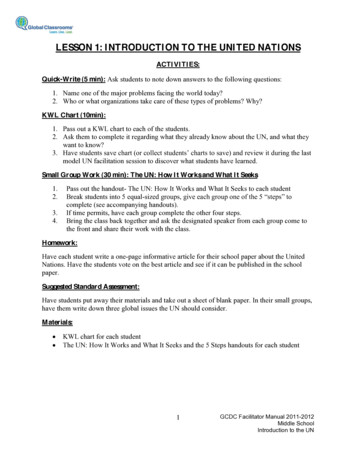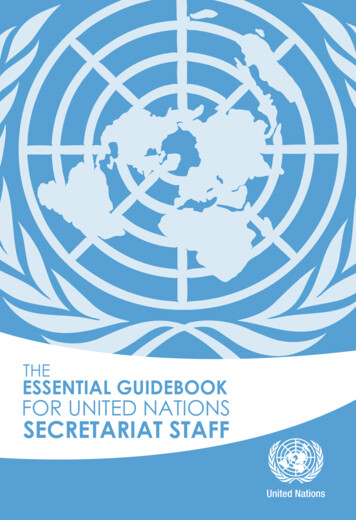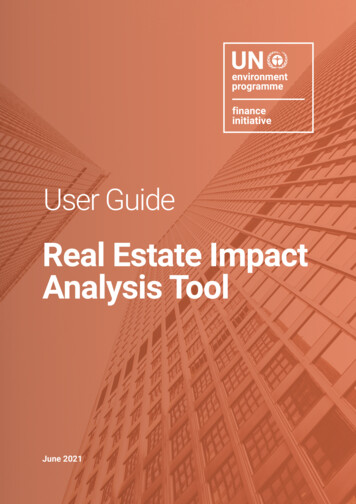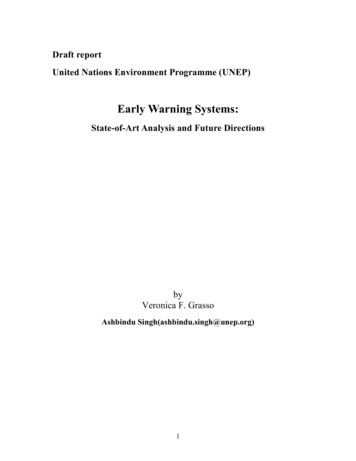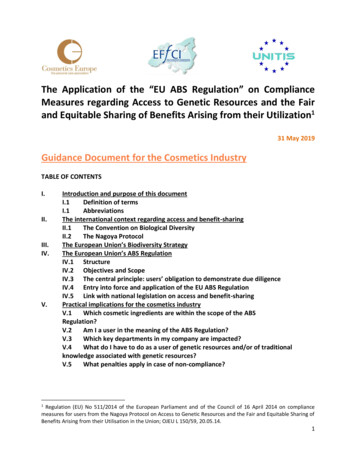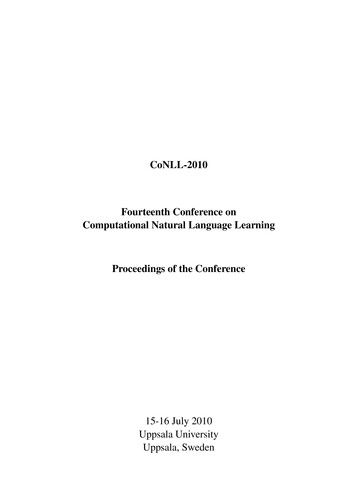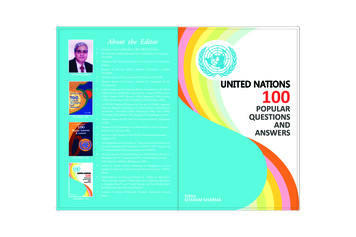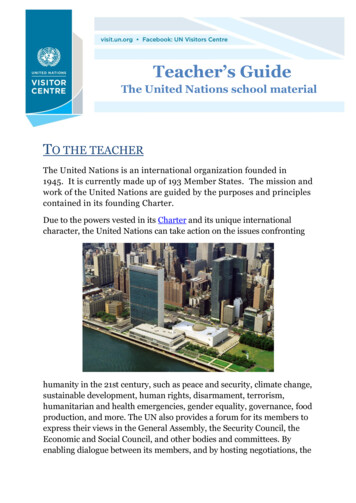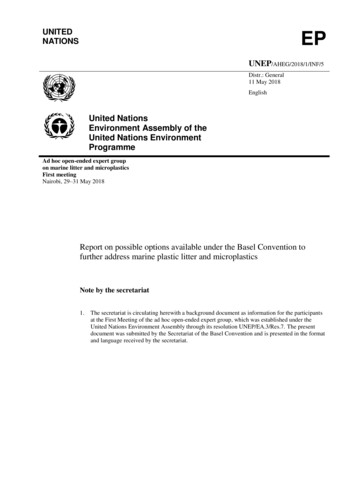
Transcription
UNITEDNATIONSEPUNEP/AHEG/2018/1/INF/5Distr.: General11 May 2018EnglishUnited NationsEnvironment Assembly of theUnited Nations EnvironmentProgrammeAd hoc open-ended expert groupon marine litter and microplasticsFirst meetingNairobi, 29–31 May 2018Report on possible options available under the Basel Convention tofurther address marine plastic litter and microplasticsNote by the secretariat1.The secretariat is circulating herewith a background document as information for the participantsat the First Meeting of the ad hoc open-ended expert group, which was established under theUnited Nations Environment Assembly through its resolution UNEP/EA.3/Res.7. The presentdocument was submitted by the Secretariat of the Basel Convention and is presented in the formatand language received by the secretariat.
UNITEDNATIONSBCUNEP/CHW/OEWG.11/INF/22Distr.: General8 May 2018English onlyOpen-ended Working Group of the Basel Conventionon the Control of Transboundary Movements ofHazardous Wastes and Their DisposalEleventh meetingGeneva, 3 6 September 2018Item 3 (b) (iv) of the provisional agenda Matters related to the work programme of theOpen-ended Working Group for 2018–2019:scientific and technical matters: marine plasticlitter and microplasticsReport on possible options available under the BaselConvention to further address marine plastic litter andmicroplasticsNote by the SecretariatAs referred to in the note by the Secretariat on marine plastic litter and microplastics(UNEP/CHW/OEWG.11/7), the annex to the present note sets out a report on possible optionsavailable under the Basel Convention to further address marine plastic litter and microplastics. Thepresent note, including its annex, has not been formally edited. UNEP/CHW/OEWG.11/1.110518
UNEP/CHW/OEWG.11/INF/22AnnexReport on possible options available under the Basel Convention tofurther address marine plastic litter and microplasticsI.Introduction1.The Conference of the Parties to the Basel Convention (COP) at its thirteenth meeting (COP13) included in the work programme of the Open-ended Working Group (OEWG) for the biennium2018-2019 an item to consider relevant options available under the Convention to further addressmarine plastic litter and microplastics and develop a proposal for possible further action, within thescope of the Convention and avoiding duplication with activities relating to the matter in other forums,for consideration by the COP at its fourteenth meeting (COP-14).1,2 This document providesbackground information and identifies possible options to assist the OEWG in considering this issueand in preparing its recommendations to the COP.3II.Nature of the problem2.Marine plastic debris has been a growing concern since the rise of the plastic industry in themid-1950s. Global plastic production has increased steadily and has reached 320 million tonnes ayear,4 growing three times faster than global gross domestic product.5 The majority of plastics areused to make items for packaging and for construction. Smaller proportions are used in a range ofother applications, including the automotive industry, agriculture, and for electrical and electroniccomponents. Of the estimated 6.3 billion tonnes of plastic waste produced since the 1950s, only 9%has been recycled and another 12% incinerated. 95% of disposable plastic packaging is wasted.63.Approximately eight million tonnes of plastic enters our oceans each year.7 UNEP hasestimated that, in the absence of action, by 2050 there will be more plastic in the sea than fish.8 Theplastic comes from a wide variety of land- and sea-based sources. These include primary production,or use in agriculture, fisheries and aquaculture, construction, transportation, shipping and offshoreindustries, tourism, textiles and clothing, sport, food and drink single-use packaging, or in cosmeticsand personal care products. Plastics pollution can arise at all stages during the life-cycle, fromleakages during production and manufacturing, abrasion while products are in use to dumping or poorpractices in handling wastes. Plastics can reach the sea by many routes – some (e.g., microbeads incosmetics) may enter watercourses via urban waste water; other plastics can come from inland orcoastal waste disposal operations, being carried by the wind or via water courses; other plastics cancome from ships or fishing vessels (e.g., lost fishing nets).4.Based on the intrinsic properties of plastics, it seems likely that they can survive in the marineenvironment for up to 500 years. Larger pieces of plastic accumulate on beaches or sink to the oceanfloor. A less significant share of plastic waste is carried on ocean currents and can accumulate inocean gyres. Under the influence of sunshine and saltwater, larger pieces can break into microplasticparticles. These are now very widely distributed through the oceans. Plastics may contain hazardoussubstances (such as some plasticizers or flame retardants) which may be slowly released into the sea,1Decision BC-13/17.The Government of Norway provided a voluntary contribution to the Basel Convention to support the activitieson marine plastic litter and microplastics included in the work programme of the Open-ended Working Group forthe biennium 2018 2019.3 This document is concerned with plastic marine debris, and UNEP has estimated that between 60% and 90% ofmarine litter comprises plastic polymers (http://cleanseas.org/download-assets). The Convention on BiologicalDiversity, for example, has used the definition: “Marine debris is usually defined as any persistent, manufacturedor processed solid material discarded, disposed of, lost or abandoned in the marine and coastal environment. Thisincludes materials transported into the marine environment from land by rivers, drainage or sewage systems orwinds. Marine debris originates from a range of sea- and land-based sources”. See decision XIII/10 on addressingimpacts of marine debris and anthropogenic underwater noise on marine and coastal biodiversity(CBD/COP/DEC/XIII/10).4 http://cleanseas.org/download-assets.5 The Economist, 2 March 2018.6 The Economist, 2 March 2018.7 http://cleanseas.org/download-assets.8 http://cleanseas.org/download-assets.22
UNEP/CHW/OEWG.11/INF/22and the plastic particles can also become contaminated with hazardous substances or pathogens andcarry them to the sea.5.Larger pieces of plastic can cause harm directly to marine animals – for example, byentanglement in debris. Many species of birds ingest smaller pieces of plastic. Plastics have beendocumented in many habitats and in over 100 species and can impact an organism at many levels.Microplastics have been documented in finfish, shellfish and crustaceans, which are consumed byhumans - the health impacts are unknown.6.It has been estimated that marine litter costs USD 8 billion to USD 13 billion a year, mainlythrough its adverse effect on fisheries, tourism and biodiversity.97.The Joint Group of Experts on Scientific Aspects of Marine Environmental Protection(GESAMP) has prepared at the request of the United Nations Environment Assembly (UNEA) twoextensive scientific reports setting out the current evidence about the sources of marine plastic litterand microplastics, the routes by which they might reach the sea and the impact on the marineenvironment.108.There is considerable international trade both in plastics and plastic waste. The greatest burdenof plastic waste entering the sea is likely to arise where waste collection systems are ineffective oreven non-existent. Developing countries in particular may face challenges in managing the rapidlygrowing volume of plastic waste. Developed countries may face challenges if they have notdeveloped sufficient capacity to dispose of plastic waste and rely on the continued availability ofrecycling capacity in other States.III.International response9.The United Nations General Assembly has expressed concern about the negative effects ofmarine debris and microplastics and has urged States to take urgent action,11 and UNEA has adoptedresolutions on marine plastic litter and microplastics at each of its first three meetings.12 UNEA, at itssecond meeting (UNEA-2), recognised that they are a rapidly increasing serious issue of globalconcern that needs an urgent global response. Many other international organizations and partnershipshave expressed similar concerns and have called for action.10.A variety of international and regional instruments and approaches exist to protect biodiversity,manage hazardous chemicals and waste and prevent pollution of the marine environment from oceanbased sources and, to a lesser degree, land-based sources of pollution. Each of these can potentiallyhelp address the problem of marine pollution by plastics. Some are legally binding, others arevoluntary initiatives or partnerships. Many of these instruments have objectives, measures or workprogrammes which address specific aspects of the challenge posed by marine plastics andmicroplastics, but none has this issue as its primary objective and none alone, as they currently stand,can provide the full solution.11.These instruments and approaches include the United Nations Convention on the Law of theSea, the International Convention for the Prevention of Pollution from Ships (MARPOL), the variousRegional Seas Conventions, the UNEP Global Programme of Action for the Protection of the MarineEnvironment from Land-based Activities and the Global Partnership on Marine Litter, as well as theBasel Convention, the Stockholm Convention and the Strategic Approach to International ChemicalsManagement (SAICM). Bodies such as GESAMP provide scientific support.12.The Global Partnership on Marine Litter has as one of its objectives “to enhance internationalcooperation and coordination through the promotion and implementation of the Honolulu Strategy, aglobal framework for the prevention and management of marine debris, as well as the HonoluluCommitment – a multi-stakeholder pledge”.13 The Honolulu Strategy includes as a goal “reducedamount and impact of land-based sources of marine debris introduced into the sea”, with a specific9http://cleanseas.org/download-assets; UNEP Year Book Emerging Issues Update: Plastic Debris in the Ocean,2014.10 The latest is Sources, Fate and Effects of Microplastics in the Marine Environment: Part Two of a GlobalAssessment, GESAMP Reports and Studies No 93 (2016), International Maritime Organization.11 Resolution 70/235 on oceans and the law of the sea adopted by the General Assembly on 23 December 2015(A/RES/70/235).12 UNEA Resolutions 1/6, 2/11 and 3/7 on marine plastic litter and microplastics (UNEA/EA.1/Res.6,UNEA/EA.2/Res.11, and UNEA/EA.3/Res.7).13 lobal-partnership-marine.3
UNEP/CHW/OEWG.11/INF/22aim to “develop, strengthen, and enact legislation and policies to support solid waste prevention,minimization and management”.1413.The 2030 Agenda for Sustainable Development contains several Sustainable DevelopmentGoals which are relevant: target 11.6 on municipal and other waste (among other issues); 12.4 on theenvironmentally sound management of chemicals and wastes; 12.5 on substantially reducing wastegeneration through prevention, reduction, recycling, and reuse; and 14.1 on reducing marine pollutionincluding marine debris.1514.Following resolution 2/11 of UNEA-2, UNEP commissioned an assessment of theeffectiveness of relevant instruments which included a mapping study of the current state of thegovernance strategies and approaches at the international, regional and sub-regional levels andidentified gaps. It examined policy options based on strengthening and better coordinating existingframeworks, and on the possibility of a new global architecture with a multi-layered governanceapproach.1615.UNEA considered the issues at its third meeting in December 2017 and, among other things,established an intersessional ad hoc open-ended expert group.17 This group will explore the barriers tocombating marine litter and microplastics and the challenges related to resources in developingcountries. It will identify the range of national, regional and international response options (includingvoluntary and legally binding options), identify their costs and benefits, examine their feasibility andmake recommendations to UNEA on options for continued work.16.The group will meet in May 2018 and, if necessary, for a second time in November 2018before reporting to UNEA at its fourth meeting (UNEA-14) in March 2019. The recommendationsfrom this group and the decisions which UNEA, at its fourth meeting, will make, will clearly be animportant consideration when the Basel Convention COP-14 considers what action it should take.Equally, it is important that conclusions reached by OEWG at its eleventh meeting (OEWG-11), arecommunicated to the expert group so that these may be factored into its own considerations.17.At a regional level, UNEP has undertaken the development and revision of marine litter actionplans in Southeast Asia, South Asia, South Pacific, Northeast Pacific, Panama and Sierra Leone.Implementation of existing action plans is also being supported in the greater Caribbean and theNorthwest Pacific regions, where regional nodes of the Global Partnership on Marine Litter have beenestablished. The Regional Plan on Marine Litter Management in the Mediterranean has been adoptedwithin the Barcelona Convention for the Protection of the Marine Environment and the CoastalRegion of the Mediterranean as a legally binding agreement.18IV.Relevance of the Basel Convention18.The Basel Convention addresses the environmentally sound management of wastes andtherefore covers many of the issues which are at the heart of reducing marine pollution from plastics –much of the plastic litter found in the sea will have been ‘waste’ as defined by the Convention, thoughnot all will necessarily fall within the definition.19.Pollution by marine plastic litter and microplastics needs to be tackled at source – it is notsustainable to clean up plastic pollution once it has entered the sea. UNEA has underlined thatpreventive action through waste minimization and environmentally sound waste management shouldbe given the highest priority.19 The waste management hierarchy – prevent, minimize, reuse, recycle,recover and dispose only as the final option – applies to plastics as to any other substance or object, iscentral to the Basel Convention and is reflected in the strategic framework and other guidanceprepared under the Convention. In addition, if plastics can be produced without potentially hazardousconstituents, the risk associated with plastic wastes can be reduced.20.As GESAMP concluded, the overarching need is for plastic and its value to be kept within theeconomy and out of the seas, via a range of circular economy measures. This will help avoid the costsof their impacts on health, environment, society and the economy. Increasing the extent 0.11822/12000/Honolulu%20strategy.pdf?sequence 1&isAllowed y.15 Other relevant targets relate to urban waste water treatment (6.3), to protection of coastal ecosystems (14.2),and to the conservation of the oceans (14.c)16 UNEP/EA.3/INF/5.17 UNEP/EA.3/Res.7.18 /other/mcbem-2014-03-120-en.pdf.19 UNEP/EA.3/Res.7.4
UNEP/CHW/OEWG.11/INF/22improving the quality of waste management is one of the most important immediate steps towardreducing inputs of debris to the ocean, particularly in developing countries.2021.UNEA has encouraged all member States to “develop and implement action plans forpreventing marine litter and microplastics, encouraging resource efficiency, including prevention andincreasing collection and recycling rates of plastic waste and re-design and re-use of products,materials and avoiding the unnecessary use of plastic and plastic containing chemicals of particularconcern where appropriate”.2122.The Basel Convention is a legally binding instrument, has almost universal membership and iscomprehensive in its approach for those waste streams which fall within its scope. It already has inplace governance structures, a Secretariat, a network of regional centres, a budget and well-establishedprocesses and work programmes. It is therefore well-placed to play a central role.23.However, while its strengths centre around its control system for the transboundary movementof hazardous and other wastes, its provisions pertaining to minimizing waste generation and toensuring their environmentally sound management are less stringent. For example, the Conventionprovides no indicators, targets, timelines or, since 2016, mandatory reporting, for reductions in wastegeneration, which makes progress towards waste minimization difficult to measure at the national,regional or global level. Similarly, while much of the technical guidance produced under theConvention is relevant to managing plastic wastes, guidance could be strengthened: it could deal morespecifically with plastics and its implementation could be monitored.V.Scope of the Basel Convention24.The Convention deals with two categories of waste. “Hazardous wastes” are those that: belongto any of the categories listed in Annex I, as further elaborated in Annexes VIII and IX, unless the useof the hazardous characteristics in Annex III demonstrate that a waste is not hazardous, or areconsidered to be hazardous wastes according to a Party’s domestic legislation. “Other wastes” arethose listed in Annex II that are subject to transboundary movement. Currently household waste andthe residues from incineration of household wastes are listed – household wastes are likely to be asignificant source of marine plastics litter.2225.Some plastic wastes may be “hazardous” – if they contain a constituent listed in Annex I orAnnex VIII which may result in the plastic being toxic or ecotoxic according to Annex III. Wastesubstances and articles containing or contaminated with polybrominated biphenyls (once commonlyused as flame retardants) for example are included in category Y10 of Annex I. But in general, thebroad range of plastic wastes are unlikely to be considered “hazardous” according to the currentdefinition in the Convention.26.Annexes I and III are currently being reviewed - the terms of reference are set out in Annex IIof decision BC-13/2. This is part of the process primarily aimed at improving the legal clarity of theConvention, but there is scope to consider extending the scope of the definition of what is hazardous.27.The “Ban Amendment23” will prohibit all transboundary movements of hazardous wastescovered by the Convention that are intended for final disposal from Parties included in a newAnnex VII (i.e. Parties and other States which are members of the OECD, the European Union, andLiechtenstein) to States not included in that Annex. It will also prohibit all transboundary movementsto States not included in that Annex of hazardous wastes covered by paragraph 1 (a) of Article 1 of theConvention that are destined for reuse, recycling or recovery operations. When this amendment entersinto force, some international flows of plastic wastes will cease, particularly when the waste streamsare hazardous. The “Ban Amendment” does not apply to “other wastes”.28.The Convention does not necessarily cover all plastic debris which may enter the sea. Forexample, plastics from industrial or commercial packaging, unless hazardous or until they become“household waste”, are not currently within the scope of the Convention. Nor, for example, are plasticparticles which arise from the abrasion of tyres or garments while in use.20Sources, Fate and Effects of Microplastics in the Marine Environment: Part Two of a Global Assessment,GESAMP Reports and Studies No. 93 (2016), International Maritime Organization.21 UNEP/EA.3/Res.7.22 While there are data about the primary uses of plastics by sector, there appear to be very limited data aboutwhat amounts of plastic flow into different waste stream – for example, how much plastic used in commercialpackaging eventually finds its way into household waste.23 anAmendment/Overview/tabid/1484/Default.aspx.5
UNEP/CHW/OEWG.11/INF/22VI.Basel Convention obligations, policies and guidelines29.In addition to its central provisions on the control of transboundary movements of wastes, theConvention sets out other obligations which are potentially relevant to marine plastic litter andmicroplastics.30.In particular, paragraph 2 (a) of Article 4 provides that each Party shall take the appropriatemeasures to ensure that the generation of hazardous wastes and other wastes is reduced to a minimum,taking into account social, technological and economic aspects. Paragraph 2 (b) of Article 4 providesthat each Party shall take the appropriate measures to ensure the availability of adequate disposalfacilities for the environmentally sound management of hazardous wastes and other wastes. Theseshall be located, to the extent possible, within it, whatever the place of their disposal. Accordingly,Parties must prevent and minimize the generation of hazardous and other wastes and manage them inan environmentally sound manner.31.These obligations have been further elaborated in various decisions and guidelines adopted bythe COP. The following declarations, frameworks, guidelines, and guidance relevant to plastics havebeen adopted over the last two decades:(a)On prevention:The Cartagena Declaration on the Prevention, Minimization and Recovery ofHazardous Wastes and Other Wastes was adopted by the COP at its tenth meeting in2012.24 Parties committed themselves to promote and implement more efficientstrategies to prevent and minimize the generation of hazardous and other wastes,particularly through measures to prevent and minimize wastes generated at source.The COP, at its twelfth meeting (COP-12) adopted a road map for the implementationof the declaration,25 and the work programme of the expert working group onenvironmentally sound management adopted at COP-13 includes further work togather good practices and examples of waste prevention and minimization.26COP-13 also adopted Guidance to assist Parties in developing efficient strategies forachieving the prevention and minimization of the generation of hazardous and otherwastes and their disposal, in which plastic waste was highlighted as a key wastestream;27 and the COP also welcomed draft practical manuals on extended producerresponsibility and financing systems for environmentally sound management.28(b)On environmentally sound management:The framework for the environmentally sound management (ESM) of hazardous wastesand other wastes was adopted by COP-11 in 2013.29 This framework was developed toidentify what countries should do at the national level and collectively to address thechallenges of implementing ESM. It is intended as a practical guide to establish acommon understanding of what ESM encompasses, to identify strategies and tools tosupport and promote its implementation. COP-13 adopted a set of Practical Manualsfor the Promotion of the Environmentally Sound Management of Wastes and extendedthe mandate of the working group to develop further the guidance and advice.30 TheESM toolkit provides practical and user-friendly tools to support Parties to claration.pdf.Decision BC-12/2.26 Decisions BC-13/2 and BC-13/3.27 Decision BC-13/3 and UNEP/CHW.13/INF/11/Rev.1.28 Decision BC-13/2 and UNEP/CHW.13/INF/8.29 Decision BC-11/1 and UNEP/CHW.11/3/Add.1/Rev.1.30 Decision BC-13/2 and spx.256
UNEP/CHW/OEWG.11/INF/22(c)Guidance and guidelines on specific types of waste:The COP has also adopted specific guidelines for particular categories of waste, or forparticular circumstances; for example:(i)Technical guidelines for the identification and environmentally soundmanagement of plastic wastes and for their disposal adopted by the COP-6 in2002.32 This document focuses mainly on the technical aspects of themanagement of plastics once they become waste, with particular emphasison their recycling. The environmental and health impacts of plastic waste arenot addressed, nor is the reduction of hazard potential of plastic products andwaste. While the document advises that waste prevention or reductioninvolves both upstream alterations in product design and in consumer habits,the guidelines offer no suggestions on this.(ii)Guidance manual on how to improve the sea-land interface to ensure thatwastes falling within the scope of MARPOL, once offloaded from a ship, aremanaged in an environmentally sound manner was adopted by COP-13.33This was produced in cooperation with the International MaritimeOrganization.(iii)Technical guidelines on the environmentally sound management of wastesconsisting of, containing or contaminated with persistent organic pollutants,which includes, for example, guidelines on wastes containing polybrominateddiphenyl ethers.34Other technical guidance covers issues such as e-waste, which may be relevant toreducing pollution by plastics. There are also a number of other relevant activities: theMobile Phone Partnership Initiative (MPPI) and the Partnership for Action onComputing Equipment (PACE) developed guidance related to mobile phones andcomputing equipment and their accessories.32.This comprehensive range of guidance provides a clear framework, which, if appliedappropriately at the national level, has the scope to address many aspects of the challenge of marinepollution by plastics.VII. Partnership approaches33.The COP has previously established a number of partnerships as an effective way of bringingtogether interested Parties and other stakeholders to cooperate to tackle important issues within thescope of the Convention.34.COP-13 formally established a household waste partnership in 2017.35 The partnership’sworkplan for 2018-2019 includes developing a guidance document on the environmentally soundmanagement of household waste. This will draw on the recommendations of three project groups,which will work on: best practices; mechanical biological treatment, energy recovery, management ofsanitary landfills and compartmentalization to deal with various waste streams; and an assessment ofcurrent waste management systems and decision-making. The Partnership will collect case studies,work on awareness-raising and training, seek to enhance people’s participation in household wastemanagement activities and decision-making and coordinate outreach activities and cooperation withother organizations working on household waste management.3635.This partnership has the potential to address a number of issues concerning pollution marineplastic and microplastics from household wastes. Alternatively, it would be possible to establish newpartnership arrangements to address plastics in waste more broadly.32Decision VI/21 and document UNEP/CHW.6/21.Decision BC-13/15, UNEP/CHW.13/18 and UNEP/CHW.13/INF/37/Rev.1.34 http://www.basel.int/tabid/5875/Default.aspx.35 UNEP/CHW.13/14.36 UNEP/CHW.13/15.337
UNEP/CHW/OEWG.11/INF/22VIII. Building international, regional and national capacity andsupporting national action36.A key part of the work of the Convention is building capacity, supporting national action, andsharing information.A.The technical assistance plan of the Basel, Rotterdam and Stockholmconventions37.At their 2017 meetings, the conferences of the Parties to the Basel, Rotterdam and Stockholmconventions each adopted decisions on technical assistance,37 by which they welcomed the technicalassistance plan38 for the implementation of the conventions for the period 2018–2021 and requestedthe Secretariat, subject to the availability of resources, to implement it in cooperation with relevantactors striving to attract the programming capacity and financial resources of relevant internationalorganizations. The plan addresses the needs of Parties to the conventions and provides them withstrengthened support, particularly developing Parties and Parties with economies in transition, in theirimplementation of the conventions and can therefore help address the issues of marine plastics andmicroplastics.B.Regional and coordinating centres38.The 23 Stockholm Convention regional centres and Basel Convention regional andcoordinating centres (six of which serve both conventions) work with Parties in their respectiveregions to promote training and technology transfer to enhance the implementation of theconventions.3939.In November 2016, regional centres established a small topic group on marine litter, led by theStockholm Convention Regional Centre in Barcelona. The topic group developed proposals for theBasel and Stockholm conventions to address issues related to marine plastic litter and microplastics,many of which are reflected in this note. They identified a number of possible future activities underboth the Basel and Stockholm conventions or other institutions to address the issue, including:development of policy guidance, dissemination of information and training activities to improveawareness and knowledge on the risks and on measures to prevent and reduce plastic litter; technicalassistance and capacity-building to support Parties and others to implement waste management andefficient waste collection measures to promote innovation and technology transfer and to avoid nonbiodegradable plastics and sound chemical substitution of toxic components in plastic packaging andother plastics.4040.At the 2017 meetings, the conferences of the Parties to the Basel and Stockholm conventioninvited th
for consideration by the COP at its fourteenth meeting (COP-14).1,2 This document provides background information and identifies possible options to assist the OEWG in considering this issue and in preparing its recommendations to the COP.3 II. Nature of the problem 2. Marine plastic de
